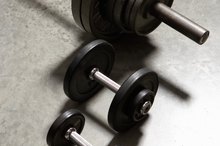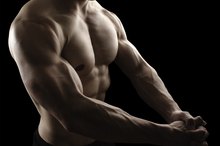Causes of Pain on the Right Side Under the Arm
According to MayoClinic.com, arm pain, including pain on the right side under the arm, may be generated by nerves, bones, muscles, tendons, ligaments or joints. Underarm pain is often the result of traumatic or overuse injuries. Underarm pain can be mild, moderate or severe, depending on the cause of the pain and the extent and the type of tissues affected.
If you are experiencing serious medical symptoms, seek emergency treatment immediately.
Brachial Plexus Injuries
According to the National Institute of Neurological Disorders and Stroke, or NINDS, the brachial plexus is a network of nerves that travel from the neck through the axilla or armpit to the upper extremities, providing sensation and motor control to various arm and hand structures. Brachial plexus injuries occur when these nerves are stretched or torn, which may happen when the shoulder is forcibly pushed downward while the head is pushed up and away from that shoulder. This type of injury usually happens in contact sports, although motor vehicle accidents, falls and certain medical conditions can also damage the brachial plexus nerves. Common symptoms include pain or discomfort under the arm, arm numbness and weakness on the affected side, and decreased motor control in the arm or hand.
- According to the National Institute of Neurological Disorders and Stroke, or NINDS, the brachial plexus is a network of nerves that travel from the neck through the axilla or armpit to the upper extremities, providing sensation and motor control to various arm and hand structures.
- Brachial plexus injuries occur when these nerves are stretched or torn, which may happen when the shoulder is forcibly pushed downward while the head is pushed up and away from that shoulder.
Triceps Muscle Strain
What Are the Causes of Pain in the Back of the Arm?
Learn More
A triceps muscle strain or a partial tear of the fibers that compose the triceps muscle or tendon can cause pain on the right side under the arm. The Sports Injury Clinic website states that the triceps muscle is a three-headed muscle that is located on the back of the upper arm 12. The triceps are responsible for extending the upper arm at the shoulder and extending the forearm at the elbow. A triceps muscle strain is a common sports-related injury, especially among weightlifters or bodybuilders. Common signs associated with a triceps muscle strain include pain under and in the back of the arm on the affected side, swelling, bruising and decreased shoulder joint active range of motion. Muscle strains, including triceps muscle strains, are graded on a scale of one to three. A grade three triceps strain is the most severe type of strain, involving significant damage to the muscle fibers composing the triceps muscle group.
- A triceps muscle strain or a partial tear of the fibers that compose the triceps muscle or tendon can cause pain on the right side under the arm.
- A grade three triceps strain is the most severe type of strain, involving significant damage to the muscle fibers composing the triceps muscle group.
Subscapularis Trigger Points
Trigger points in the right subscapularis muscle can cause pain on the right side under the arm. The subscapularis muscle is a large, triangular muscle that occupies the subscapular fossa on the underside of the scapula or shoulder blade. The subscapularis muscle, which is one of four rotator cuff muscles acting on the shoulder, lies between the shoulder blade and the torso. According to the National Association of Myofascial Trigger Point Therapists, or NAMTPT, a trigger point is a hyper-irritable nodule or knot that develops within a tight band of muscle 3. Trigger points cause pain when they are pressed, and they can refer or send pain to other parts of the body too. The NAMTPT states that trigger points form in muscles, including the subscapularis muscle, due to repetitive strain injuries, poor posture, direct trauma or inactivity. Muscles that harbor trigger points may be painful and lack a full active range of motion.
- Trigger points in the right subscapularis muscle can cause pain on the right side under the arm.
- The subscapularis muscle, which is one of four rotator cuff muscles acting on the shoulder, lies between the shoulder blade and the torso.
Related Articles
References
- Mayo Clinic: Arm Pain
- Sports Injury Clinic: Inflammation and Rupture of the Triceps Tendon
- National Association of Myofascial Trigger Point Therapists: Myofascial Trigger Point Therapy
- Jafri MS. Mechanisms of myofascial pain. Int Sch Res Notices. 2014. doi:10.1155/2014/523924
- Desai MJ, Saini V, Saini S. Myofascial pain syndrome: a treatment review. Pain Ther. 2013;2(1):21-36. doi:10.1007/s40122-013-0006-y
- Celik D, Mutlu EK. Clinical implication of latent myofascial trigger point. Curr Pain Headache Rep. 2013;17(8):353. doi:10.1007/s11916-013-0353-8
- Bron, C., de Gast, A., Dommerholt, J. et al. Treatment of myofascial trigger points in patients with chronic shoulder pain: a randomized, controlled trial. BMC Med 9, 8 (2011) doi:10.1186/1741-7015-9-8
- Shah JP, Thaker N, Heimur J, Aredo JV, Sikdar S, Gerber L. Myofascial trigger points then and now: a historical and scientific perspective. PM R. 2015;7(7):746-761. doi:10.1016/j.pmrj.2015.01.024
- Oh, Sejun, et al. “Effect of Myofascial Trigger Point Therapy with an Inflatable Ball in Elderlies with Chronic Non-Specific Low Back Pain.” Journal of Back and Musculoskeletal Rehabilitation, vol. 31, no. 1, June 2018, pp. 119–126., doi:10.3233/bmr-169696.
- N10CTÂ View Profile
- ho_124Â View Profile
- mivi320Â View Profile
Writer Bio
Martin Hughes is a chiropractic physician, health writer and the co-owner of a website devoted to natural footgear. He writes about health, fitness, diet and lifestyle. Hughes earned his Bachelor of Science in kinesiology at the University of Waterloo and his doctoral degree from Western States Chiropractic College in Portland, Ore.









